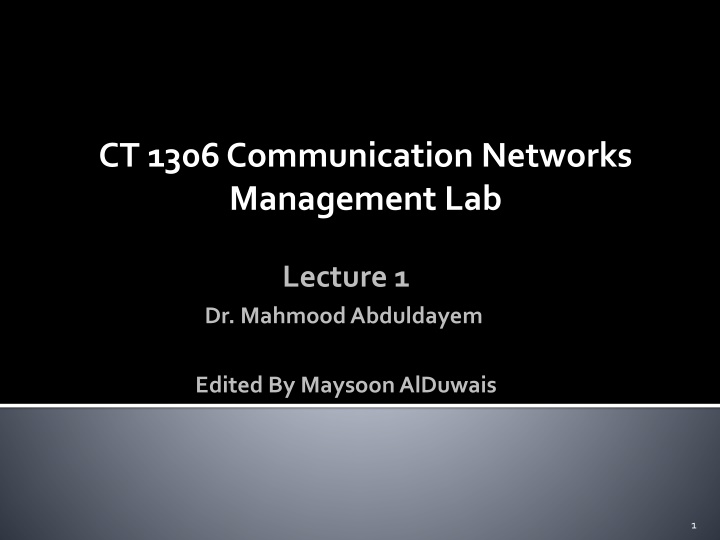
Communication Networks Management for Efficient Operations
Communication Networks Management involves activities to operate, manage, maintain, and control network resources. Responsibilities include maintaining network stability, monitoring for issues, tracking resources, implementing corrective measures, and utilizing protocols like SNMP for effective management.
Download Presentation

Please find below an Image/Link to download the presentation.
The content on the website is provided AS IS for your information and personal use only. It may not be sold, licensed, or shared on other websites without obtaining consent from the author. If you encounter any issues during the download, it is possible that the publisher has removed the file from their server.
You are allowed to download the files provided on this website for personal or commercial use, subject to the condition that they are used lawfully. All files are the property of their respective owners.
The content on the website is provided AS IS for your information and personal use only. It may not be sold, licensed, or shared on other websites without obtaining consent from the author.
E N D
Presentation Transcript
CT 1306 Communication Networks Management Lab Lecture 1 Dr. Mahmood Abduldayem Edited By Maysoon AlDuwais 1
Communication Networks Management: Refers to the activities, methods, procedures, and tools related to operate, manage, maintain, and control resources for network systems. it includes the following responsibilities: Maintaining the stability of the network performance (and the services provided by the network) to work smoothly. Monitoring the network to discover problems as soon as possible, before users are affected. 1. 2. 2
3. Tracking resources in the network and how they joined the network. 4. Doing all the necessary procedures to keep the network under control. 5. Fixing and developing the network continuously to maintain its performance. For example: Exchanging old network devices. When new devices (such as Switch) is added to the network. 3
6. Implementing corrective and preventive procedures to increase the network performance, such as: modifying the control parameters (Configuration) of network device. 7. controlling resources in the network to support a particular service. Example: setting up the network so that users can have new service such as voice. 4
SNMP(v1, v2, v3) Simple Network Management Protocol ICMP Internet Control Message Protocol Ping , traceroute ARP/RARP Address Resolution Protocol/ (Reverse ARP) TCP Socket Telnet/SSH HTTP+XML
SNMP is an acronym for "Simple Network Management Protocol" SNMP is one of the seventh layer (Application Layer) protocols, the layer that is used by the network management system to monitor devices connected to the network. SNMP is part of the Internet protocol package as defined by the IETF. 6
Loss of connectivity (Link, Node, Interface) Duplicate IP address (Procedural) Intermittent problems A system interface problem in a shared medium Network configuration issues Non-problems The cause of failure is a mystery. (Turn off , Turn on) Performance problems The cause of long network delay and increasing the response time
Network Management Network Provisioning Network Operations Network Maintenance Planning Fault Management / Service Restoration Fault Management Design Configuration Management Trouble Ticket Administration Performance Management / Traffic Management Network Installation Security Management Network Repairs Accounting Management Facilities Installation & Maintenance Routine Network Tests Reports Management Inventory Management Data Gathering & Analyses Figure 1.21 Network Management Functional Groupings
Network Users Configuration Data Management Decision TT Restoration Performance & Traffic Data New Technology I & M Group Engineering Group Operations Group NOC - Network Planning & Design -Network Installation & Maintenance - Network Operations Fault TT Installation Figure 1.22. Network Management Functional Flow Chart
Fault Management detection, isolation and correction of abnormal operations Configuration Management identify managed resources and their connectivity, discovery Accounting Management keep track of usage for charging Performance Management monitor and evaluate the behavior of managed resources Security Management allow only authorized access and control FCAPS
http://www.washington.edu/lst/help/computing_fundamentals/networking/img/osi_model.jpghttp://www.washington.edu/lst/help/computing_fundamentals/networking/img/osi_model.jpg 11
Functions that are implemented as part of the network management include: Monitoring, planning ,allocation, deployment, coordination of network resources Network planning, Directing the traffic of the data to balance the load of data in the network. Encryption key distribution. Setting management. Fault management Security management Performance management Bandwidth management 12
The data are collected to manage the network using different methods as follows: Software agents installed on infrastructure of the network Artificial monitoring programs that simulate transactions Activity log files Spyware Sniffer Real monitoring by the user. Today performance management has become an essential responsibility of the information technology (IT) team. Note: network management does not include terminal users. 13
